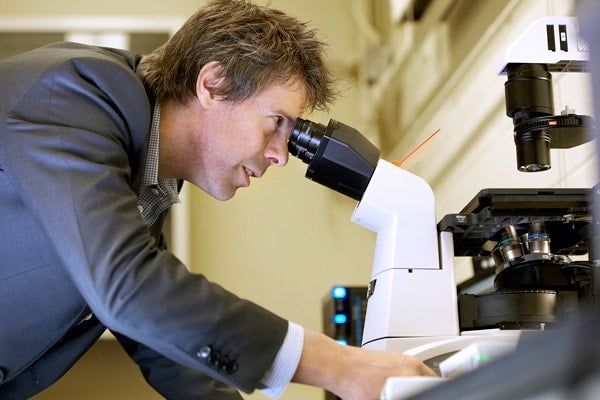
Professor Gregory Scholes wins John C. Polanyi Award
Published: February 27, 2013
Professor Gregory Scholes is a leader in the field of energy transfer — the process whereby absorbed light is transferred from molecule to molecule - and this year's recipient of the Natural Sciences and Engineering Research Council of Canada John C. Polanyi Award.
The Polanyi award was established in tribute to John Polanyi, a Nobel laureate who is himself a University of Toronto researcher in the Department of Chemistry.
Scholes has shown that quantum mechanical effects are involved in the capture and distribution of the sun’s energy during photosynthesis. By demonstrating the connection between biology and quantum physics, his work raises significant questions on how far quantum laws reach and whether they influence complex living systems.
The interest in these questions is high. Scholes’ work has been featured in Nature, Wired, Scientific American and on CBC News, Discovery and Quirks and Quarks. By studying the mechanisms used by some natural organisms to capture and make use of the sun’s energy with extreme efficiency, humanity could learn crucial lessons in making better use of solar conversion to meet our own growing energy needs.
Scholes' recent work on light-harvesting in marine algae has shown that light-absorbing molecules in some photosynthetic proteins capture and transfer energy according to laws of quantum mechanical probability — work that opens new windows of opportunity for physicists and engineers to study the effective capture of photons and the transfer of light energy.
U of T News asked Scholes to discuss his work and its implications for future generations.
Tell us about your research.
I'm interested in processes initiated by light. Owing to the quite large energy carried by a photon of visible light, a great variety of processes can be activated, including production of electrical energy in organic materials and nature. Photosynthesis is a wonderful example, where light absorbed by chlorophyll initiates an incredible cascade of processes that transport and transform the energy--starting with extraordinarily fast (1-^-13s!!) events.
By studying such systems we learn how they work, which inspires new ideas and perhaps technologies.
What kind of impact could this research have for society?
I am primarily concerned with training the next generation of scientists at the cutting edge of research. Applications of the kinds of processes we investigate include solar energy conversion, photochemical energy storage or amplification of sensors.
What sort of changes or developments have you witnessed over the course of your career?
It is surprising how fast the frontiers of fields change. Trends in "hot topics" and funding drives research and discoveries happen rapidly. In parallel, new experimental technologies and theoretical tools mean we can address ever more challenging questions.
Certainly the kinds of questions we can tackle now we only dreamt of when I started at U of T, which was only 12 or so years ago.
Why U of T?
I was simply impressed with the chemistry department at U of T and collegial atmosphere. I was also greatly impressed by the achievements of my future colleagues.
What advice would you give to a student just starting out in this field?
Learn to ask the right questions and use them to direct your research. A compelling question motivates top tier research.



